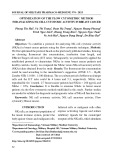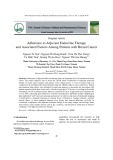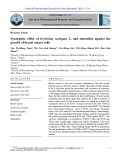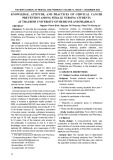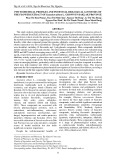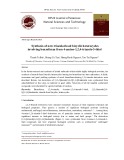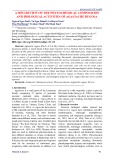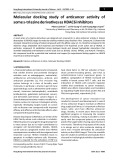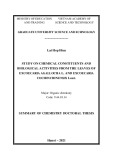Modulation of the endocannabinoid system by focal brain ischemia in the rat is involved in neuroprotection afforded by 17b-estradiol Diana Amantea1, Paola Spagnuolo1,2, Monica Bari2,3, Filomena Fezza2,3, Cinzia Mazzei1, Cristina Tassorelli4, Luigi A. Morrone1, Maria T. Corasaniti3,5, Mauro Maccarrone3,6,* and Giacinto Bagetta1,*
1 Department of Pharmacobiology and University Center for the Study of Adaptive Disorder and Headache (UCADH),
Section of Neuropharmacology of Normal and Pathological Neuronal Plasticity, University of Calabria, Rende (CS), Italy
2 Department of Experimental Medicine and Biochemical Sciences, University of Rome Tor Vergata, Rome, Italy 3 IRCCS Neurological Institute C. Mondino Foundation, Mondino-Tor Vergata Center for Experimental Neuropharmacology,
Laboratory of Neurochemistry, Rome, Italy
4 Laboratory of Pathophysiology of Integrative Autonomic Systems, IRCCS Neurological Institute C. Mondino Foundation and University
Centre for the Study of Adaptive Disorder and Headache (UCADH), Pavia, Italy
5 Department of Pharmacobiological Sciences, University Magna Graecia of Catanzaro, Italy 6 Department of Biomedical Sciences, University of Teramo, Italy
Keywords endocannabinoids; estrogen; middle cerebral artery occlusion; stroke
Correspondence G. Bagetta, Department of Pharmacobiology, University of Calabria, via P. Bucci Ed. Polifunzionale, 87036 Rende (CS), Italy Fax: +39 0984 493462 Tel: +39 0984 493462 E-mail: g.bagetta@unical.it
*These authors contributed equally to this work
(Received 28 March 2007, revised 18 June 2007, accepted 3 July 2007)
doi:10.1111/j.1742-4658.2007.05975.x
Endogenous levels of the endocannabinoid anandamide, and the activities of the synthesizing and hydrolyzing enzymes, i.e. N-acylphosphatidyletha- nolamine-hydrolyzing phospholipase D and fatty acid amide hydrolase, respectively, were determined in the cortex and the striatum of rats sub- jected to transient middle cerebral artery occlusion. Anandamide content was markedly increased ((cid:2) 3-fold over controls; P < 0.01) in the ischemic striatum after 2 h of middle cerebral artery occlusion, but not in the cortex, and this elevation was paralleled by increased activity of N-acylphosphati- phospholipase D ((cid:2) 1.7-fold; P < 0.01), dylethanolamine-hydrolyzing and reduced activity ((cid:2) 0.6-fold; P < 0.01) and expression ((cid:2) 0.7-fold; P < 0.05) of fatty acid amide hydrolase. These effects of middle cerebral artery occlusion were further potentiated by 1 h of reperfusion, whereas anandamide binding to type 1 cannabinoid and type 1 vanilloid receptors was not affected significantly by the ischemic insult. Additionally, the can- nabinoid type 1 receptor antagonist SR141716, but not the receptor agonist R-(+)-WIN55,212-2, significantly reduced (33%; P < 0.05) cerebral infarct volume detected 22 h after the beginning of reperfusion. A neuroprotective intraperitoneal dose of 17b-estradiol (0.20 mgÆkg)1) that reduced infarct size by 43% also minimized the effect of brain ischemia on the endocanna- binoid system, in an estrogen receptor-dependent manner. In conclusion, we show that the endocannabinoid system is implicated in the pathophysi- ology of transient middle cerebral artery occlusion-induced brain damage, and that neuroprotection afforded by estrogen is coincident with a re- establishment of anandamide levels in the ischemic striatum through a mechanism that needs to be investigated further.
Abbreviations AEA, anandamide (arachidonoylethanolamide); CB, cannabinoid; CNS, central nervous system; E2, 17b-estradiol; ER, estrogen receptor; FAAH, fatty acid amide hydrolase; MCA, middle cerebral artery; MCAo, middle cerebral artery occlusion; NAPE, N-acylphosphatidyl- ethanolamine; NAPE-PLD,N-acylphosphatidylethanolamine-hydrolyzing phospholipase D; NArPE, N-arachidonoylphosphatidylethanolamine; RTX, resinferatoxin; TRPV1, transient receptor potential vanilloid-1; TTC, 2,3,5-triphenyltetrazolium chloride.
FEBS Journal 274 (2007) 4464–4475 ª 2007 The Authors Journal compilation ª 2007 FEBS
4464
D. Amantea et al.
Endocannabinoid system modulation by E2 after MCAo
subjected to focal brain ischemia [18–20,24]. Similar results have been obtained in male rats, as either acute or chronic E2 administration significantly reduces brain damage following transient MCAo [25].
Although the neuroprotective
effects of E2
in humans are controversial [26], there is evidence that E2 enhances recovery from brain injury following cerebral ischemia [27,28], and continued use of estrogens has been shown to significantly reduce the risk of stroke [29–31]. This is also confirmed by epidemiologic evi- dence indicating that women are more protected than men against stroke until the menopause [27]. However, recent large, randomized, clinical trials have questioned the effectiveness of female sex hormones in the preven- tion of coronary heart disease and stroke [32–34].
Endocannabinoids are amides, esters and ethers of long-chain polyunsaturated fatty acids that are synthe- sized on demand. Anandamide (arachidonoylethanol- amide) (AEA) was the first member of this family to be discovered [1], and it is synthesized by the enzyme N-acylphosphatidylethanolamine (NAPE)-hydrolyzing phospholipase D (NAPE-PLD) [2]. Following cellular depolarization and Ca2+ influx, endocannabinoids are released into the extracellular space and interact with type 1 and type 2 cannabinoid (CB1 and CB2) recep- tors, non-CB1 ⁄ non-CB2 receptors, and noncannabi- noid receptors, including the type 1 vanilloid receptor [transient receptor potential vanilloid-1 (TRPV1)], a ligand-gated and nonselective cationic channel [3]. The biological actions of AEA cease following cellular uptake, mediated by a membrane transporter [4], and intracellular degradation catalyzed by a subsequent fatty acid amide hydrolase (FAAH), which cleaves the amide bond to form arachidonic acid and ethanol- amine [5]. Taken together, AEA, its congeners and the proteins that bind, synthesize or transport them form the ‘endocannabinoid system’ [6].
Several mechanisms have been suggested to underlie E2 neuroprotection, including modulation of synapto- genesis, protection against apoptosis, anti-inflamma- tory activity, and increased cerebral blood flow. Estrogens exert their activity through the interaction with intracellular estrogen receptors (ERs), ERa and ERb, which results in the modulation of the transcrip- tion of estrogen target genes, including those impli- cated in neuronal survival. ER activation may also mediate rapid nongenomic effects of E2 via interaction with intracellular signaling cascades. However, there is evidence documenting that neuroprotection may also occur via interaction with ER-like membrane recep- tors, mediating rapid, nongenomic actions, or recep- to the tor-independent mechanisms, mainly due antioxidant free radical-scavenging properties of the steroidal molecules [35]. However, the exact contribu- tion of each molecular mechanism to the overall neu- rotrophic and neuroprotective effect of estrogens is still a matter of debate.
In the brain, endocannabinoids act as retrograde messengers to control multiple central nervous system (CNS) functions, including learning and memory, pain, sleep, and appetite [7]. Moreover, there is experimental evidence to support a dual role for AEA in the CNS as a neuroprotective or neurotoxic agent [8,9]. Endo- cannabinoids are indeed elevated in a variety of acute neurodegenerative insults, such as decapitation-induced ischemia [10], N-methyl-d-aspartate (NMDA)-induced excitotoxicity [11], convulsions [12], traumatic brain injury [13], and notably middle cerebral artery (MCA) occlusion (MCAo) [14,15]. This elevation has been sug- gested to represent an endogenous protective mecha- nism during CNS injury [16]. By contrast, recent studies have suggested that endogenously released en- docannabinoids may be toxic to neurons in animal models of acute neurodegeneration. Thus, for instance, both CB1 receptor stimulation and blockade have been shown to exert neuroprotection in rodent models of focal brain ischemia [14,15,17].
Interestingly, recent studies have revealed that sex hormones may provide pivotal modulation of the endocannabinoid system in a tissue- and species-spe- cific manner, as demonstrated both in vivo, in mouse uterus, and in vitro, in human endothelial, lymphoma and neuroblastoma cells [36,37]. In particular, the endocannabinoid AEA is released from human endo- thelial cells treated with E2, and complements some this hormone on human platelets [38]. actions of However, the endocannabinoid the modulation of system by estrogen in the brain has been poorly investigated.
Recent studies have highlighted the ability of estro- gens to enhance recovery from ischemic brain injury resulting from cardiovascular disease or cerebrovascu- lar stroke. 17b-estradiol (E2) has been shown to reduce mortality and cerebral damage in a variety of animal models of acute cerebral ischemia, including transient and permanent MCAo [18–20], photothrombotic focal ischemic brain damage [21], and global forebrain ische- mia [22,23]. Accordingly, administration of either pharmacologic or physiologic doses of E2 provides rodents neuroprotection in ovariectomized female
In the present study, we aimed to evaluate the effect of MCAo-induced brain insult on AEA regional level, metabolism, and receptor binding and expression. The putative neuroprotective action of agonists and antagonists of cannabinoid receptors has also been investigated. Moreover, we demonstrate here that
FEBS Journal 274 (2007) 4464–4475 ª 2007 The Authors Journal compilation ª 2007 FEBS
4465
D. Amantea et al.
Endocannabinoid system modulation by E2 after MCAo
Results
modulation of the endocannabinoid system is implicated in the mechanisms of neuroprotection afforded by acute administration of a pharmacologic dose of estrogen in male rats.
Two hours of MCAo resulted in a significant increase in endogenous AEA levels in the striatum ipsilateral to the ischemic damage, but not in the cerebral cortex. Inter- estingly, when reperfusion was allowed for 1 h following 2 h of MCAo, endogenous levels of AEA were higher than those detected in the striata of rats subjected to brain ischemia without reperfusion (Fig. 1A).
In order to evaluate whether ischemia-induced changes in endogenous AEA levels were associated with altered endocannabinoid metabolism, the activity of FAAH was measured in cortices and striata from rats with focal brain ischemia. Two hours of MCAo, with or without 1 h of reperfusion, resulted in a significant decrease in FAAH activity as detected in the striatum, but not in the cortex, ipsilateral to the ischemic damage (Fig. 1B).
Furthermore, increased AEA levels in the ischemic striatum were also associated with a significant increase in NAPE-PLD activity, as detected following 2 h of MCAo (Fig. 1C). More interestingly, re-estab- lishment of the blood supply for 1 h resulted in a more pronounced increase in the activity of NAPE-PLD, as compared to the enzymatic activity measured in striata after 2 h of MCAo without reperfusion (Fig. 1C). By contrast, focal brain ischemia did not appear to affect NAPE-PLD activity in the cerebral cortex, and this is consistent with the lack of significant changes in endogenous AEA levels detected in this ischemic corti- cal region (Fig. 1A).
The increase in endogenous AEA levels detected in the striatum was persistent also at later stages of reper- fusion following 2 h of MCAo (Fig. 2). By contrast, levels of AEA, which did not significantly cortical change after 1 h of reperfusion, were significantly reduced 6 h or 22 h later (Fig. 2).
Unlike endocannabinoid metabolism, which appears to be modified as a consequence of focal brain ische- mia, CB1 and TRPV1 receptor binding in cortices and striata did not change following 2 h of MCAo, either in the absence or in the presence of 1 h of reperfusion (data not shown).
Fig. 1. Endogenous levels of AEA (A) and activity of FAAH (B) and NAPE-PLD (C) in the ischemic striatum and cortex of rats subjected to 2 h of MCAo, with or without 1 h of reperfusion. Sham rats were exposed to the same surgical procedure without occlusion of the MCA. E2 (0.20 mgÆkg)1, intraperitoneal) was administered 1 h before MCAo. Values are expressed as mean ± SD (n ¼ 3), and were analyzed by the Mann–Whitney U-test. *P < 0.01 versus Sham; #P < 0.01 versus MCAo; §P < 0.05 versus MCAo.
FEBS Journal 274 (2007) 4464–4475 ª 2007 The Authors Journal compilation ª 2007 FEBS
4466
D. Amantea et al.
Endocannabinoid system modulation by E2 after MCAo
200
Striatum
Cortex
***
A E A
**
150
*
f o s
l
e v e
l
100
) l o r t n o c
* ,#
* ,##
f o %
(
50
s u o n e g o d n E
0
0
1.0
6.0
22.0
Reperfusion (h)
Fig. 2. Endogenous levels of AEA in the striatum and cortex of rats subjected to 2 h of MCAo, followed by 0, 1, 6 or 22 h of reperfu- sion (100% as MCAo samples in Fig. 1A). Values are expressed as mean ± SD (n ¼ 3), and were analyzed by the Mann–Whitney U-test. *P < 0.05, **P < 0.01 and ***P < 0.001 versus 0 h of reperfusion; #P < 0.01 and ##P < 0.001 versus 1 h of reperfusion.
Fig. 3. FAAH and CB1 receptor content in the striatum of rats sub- jected to 2 h of MCAo, with or without 1 h of reperfusion. Sham rats were exposed to the same surgical procedure without occlusion of the MCA. E2 (0.20 mgÆkg)1, intraperitoneal) was administered 1 h before MCAo. Values are expressed as mean ± SD (n ¼ 4), and were analyzed by the Mann–Whitney U-test. **P < 0.05 versus Sham; §P < 0.05 versus MCAo.
(0.20 mgÆkg)1,
The lack of change in CB1 receptor binding capacity following MCAo was also confirmed by data showing that CB1 receptor striatal content was not modified by focal ischemic insult (Fig. 3). By contrast, striatal con- tent of the metabolic enzyme FAAH was significantly reduced following 2 h of MCAo, with or without 1 h of reperfusion (Fig. 3). The latter finding is consistent with the reduced activity of FAAH in the ischemic stri- atum of rats that have undergone MCAo (Fig. 1B). The lack of specific antibodies to NAPE-PLD pre- vented us from further extending the analysis of pro- tein content to this enzyme.
E2 on endogenous AEA levels in both ischemic cortex and striatum was evaluated. The results showed that intraperitoneal) administered 1 h E2 before MCAo significantly reversed the increase of endogenous AEA levels produced by 2 h of focal cere- bral ischemia in the striatum (Fig. 1A). Moreover, FAAH and NAPE-PLD activities returned to basal (sham) levels when rats were treated with the same dose of E2 1 h prior to MCAo (Fig. 1B,C). It seems of further interest that, although brain ischemia did not alter cannabinoid receptor expression, E2 pretreatment resulted in a significant (45%) reduction of CB1 bind- ing in the striatum, but not in the cortex ipsilateral to the ischemic insult (data not shown). Instead, CB1 receptor content was not affected by the hormone treatment (Fig. 3), and neither was TRPV1 binding (data not shown).
In order to evaluate whether increased AEA levels following MCAo might contribute to ischemic brain damage or, conversely, might serve as an endogenous neuroprotective mechanism, we assessed the effect of CB1 receptor blockade or activation on ischemic dam- age. We found that administration of the CB1 recep- tor antagonist SR141716 (3 mgÆkg)1, intraperitoneal), 15 min before MCAo, resulted in a significant reduc- tion in brain infarct volume as detected 22 h after rep- erfusion (Fig. 4A–C). By contrast, pretreatment with the cannabinoid receptor agonist R-(+)-WIN-55,212-2 (1 mgÆkg)1, intraperitoneal, 15 min before MCAo) did not affect brain infarct damage produced by transient MCAo (Fig. 4D).
Interestingly, E2 does not appear to significantly modulate basal levels of AEA, FAAH and NAPE- PLD activity and CB1 receptor binding as assessed in striatal samples from sham-operated rats, pretreated with E2 or vehicle, 3 h before sacrifice (Table 1). This suggests that neuropathologic alterations of the endoc- annabinoid system, such those detected after MCAo, are instrumental for its modulation by estrogen.
The modulation of the endocannabinoid system by E2 in the ischemic striatum seems to involve the activa- tion of intracellular ERs. In fact, administration of the
Estrogens are known to protect the brain against focal ischemia [35]. In order to investigate the role of the endocannabinoid system in the neuroprotection afforded by estrogen, the effect of acute treatment with
FEBS Journal 274 (2007) 4464–4475 ª 2007 The Authors Journal compilation ª 2007 FEBS
4467
D. Amantea et al.
Endocannabinoid system modulation by E2 after MCAo
Fig. 4. SR141716, a selective CB1 receptor antagonist, but not WIN55,212-2, a CB1 receptor agonist, reduces brain infarct size following transient MCAo. The right MCA was occluded for 2 h with a nylon suture, as described in Experimental procedures, and cerebral infarct vol- ume was evaluated 22 h after reperfusion. Eight serial sections from each brain were cut at 2 mm intervals from the frontal pole and incu- bated in TTC, which stains viable tissue red but not infarcted areas (C). The infarct volume was calculated by summing the infarcted area of the eight sections (A) and multiplying by the interval thickness between sections. Rats received vehicle (vegetable oil, n ¼ 5) or SR141716 (3 mgÆkg)1, n ¼ 4) intraperitoneally, 15 min prior to MCAo (A–C). In another set of experiments, rats received vehicle (propylene glycol, n ¼ 7) or WIN55,212-2 (1 mg kg)1, n ¼ 7) intraperitoneally, 15 min prior to MCAo (D).Values are expressed as mean ± SEM, and were compared by unpaired two-tailed t-test. *P < 0.05 versus vehicle.
Table 1. Effect of acute administration of E2 on the endocannabi- noid system in striatal tissue from sham-operated rats. Rats were treated with E2 (0.2 mgÆkg)1, intraperitoneal) or vehicle (vegetable oil, 1 mLÆkg)1, intraperitoneal), 3 h before sham operation. Values are expressed as mean ± SD (n ¼ 3), and were analyzed by the Mann–Whitney U-test.
resulted in a significant reduction of brain infarct volume produced by 2 h of MCAo followed by 22 h of reperfusion. The neuroprotection afforded by E2 was reverted by the ER antagonist ICI182 780 (0.25 mgÆkg)1, intraperitoneal), administered 1 h prior to E2 (Fig. 6).
Vehicle
E2
35 ± 3
30 ± 9
Discussion
820 ± 80 884 ± 90
22 ± 3
25 ± 3
190 ± 20 180 ± 20
Endogenous AEA [pmolÆ(mg protein))1] FAAH activity [pmolÆmin)1Æ(mg protein))1] NAPE-PLD activity [pmolÆmin)1Æ(mg protein))1] CB1 receptor binding [fmolÆ(mg protein))1]
significantly
increased.
ER antagonist ICI182 780 (0.25 mgÆkg)1, intraperito- neal, 1 h prior to E2) was able to significantly antago- nize the effects of E2 (0.20 mgÆkg)1, intraperitoneal, 1 h before MCAo) on endogenous levels of AEA, on FAAH and NAPE-PLD activity, and on CB1 receptor binding in the striatum (Fig. 5).
Interestingly, acute treatment with E2 (0.20 mgÆkg)1, intraperitoneal), given 1 h before the ischemic insult,
The results reported in the present study demonstrate that a focal ischemic brain insult produced by transient MCAo results in a significant increase of endogenous AEA levels in the ischemic striatum, as early as 2 h following injury. This effect was associated with altered endocannabinoid metabolism, as 2 h of MCAo also resulted in reduced activity and expression of the metabolic enzyme FAAH, whereas NAPE-PLD activ- ity was Interestingly, we observed that reperfusion increased striatal AEA levels above those detected after 2 h of MCAo, thus suggest- ing that re-establishment of blood supply may further
FEBS Journal 274 (2007) 4464–4475 ª 2007 The Authors Journal compilation ª 2007 FEBS
4468
D. Amantea et al.
Endocannabinoid system modulation by E2 after MCAo
75
A
) 2
Vehicle E2 ICI + E2
m m
50
(
a e r a
25
t c r a f n
I
0
0
1
2
4
5
7
8
3 6 coronal section
B
600
) 3
m m
400
**
l
200
( e m u o v t c r a f n
I
0
Vehicle
E2
ICI + E2
Fig. 5. The observed effects of E2 on endogenous levels of AEA, on FAAH and NAPE-PLD activity, and on CB1 receptor binding in the striatum of rats following MCAo appear to be mediated by E2 receptor stimulation, as these effects are reversed by ICI182 780, a pure ER antagonist. Values are expressed as mean ± SD (n ¼ 4), and analyzed by the Mann–Whitney U-test. #P < 0.01 versus MCAo; §P < 0.05 versus MCAo; @P < 0.01 versus MCAo + E2; &P < 0.05 versus MCAo + E2.
is
supported by the evidence that
Fig. 6. Neuroprotection afforded by E2 against brain damage pro- duced by transient MCAo is reversed by ICI182 780, a pure ER antagonist. The right MCA was occluded for 2 h with a nylon suture, as described in Experimental procedures, and cerebral infarct volume was evaluated 22 h after reperfusion. Eight serial sections from each brain were cut at 2 mm intervals from the fron- tal pole and incubated in TTC, which stains viable tissue red but not infarcted areas. The infarct volume (B) was calculated by sum- ming the infarcted area of the eight sections (A) and multiplying by thickness between sections. Rats received E2 the interval (0.20 mgÆkg)1, intraperitoneal, 1 h before MCAo), alone or in combi- nation with ICI182 780 (0.25 mgÆkg)1, intraperitoneal, 1 h prior to E2). Values are expressed as mean ± SEM (n ¼ 5), and were ana- lyzed by ANOVA followed by Tukey’s post hoc test. **P < 0.01 ver- sus vehicle.
contribute to endocannabinoid modulation. The latter the hypothesis increase in NAPE-PLD activity was more pronounced following 1 h of reperfusion, as compared to the enzy- matic activity measured after MCAo alone. Thus, it is conceivable that an early increase in endogenous AEA levels in the ischemic striatum, which comprises most of the ischemic core [39], might underlie brain damage produced by focal ischemia. This effect appears to occur via activation of cannabinoid receptors, as pre- treatment with the CB1 receptor antagonist SR141716 afforded neuroprotection in rats subjected to transient MCAo.
the
susceptibility to the ischemic insult, 2 h of MCAo being not enough to produce significant AEA elevation in the penumbral region. By contrast, we did observe a reduction in AEA levels in the cortex at later stages of reperfusion, which may indeed be the result of delayed damage, as compared to the striatum [39]. However, the exact pathophysiologic significance of the latter observation needs to be investigated further.
Endogenous levels of AEA are elevated by decapita- tion-induced ischemia [10], NMDA-induced excitotox- icity in vivo [11], neonatal traumatic brain injury [11], kainate-induced neuronal excitation [40] and, most notably, MCAo [15]. This elevation of AEA has been
An early increase of AEA has been previously reported in the whole brain of rats following transient focal brain ischemia [15]. However, in that study, no alterations information was collected about induced by the ischemic insult in different brain regions, and neither was the biochemical background behind the effect of MCAo on AEA levels investigated [15]. We did observe an early significant increase in endogenous AEA levels in the ischemic striatum but not in the cortex of rats subjected to MCAo. The lack of acute changes in endocannabinoid levels in the cortical regions may stem from differential regional
FEBS Journal 274 (2007) 4464–4475 ª 2007 The Authors Journal compilation ª 2007 FEBS
4469
D. Amantea et al.
Endocannabinoid system modulation by E2 after MCAo
signifi- AEA-synthesizing enzyme NAPE-PLD was cantly increased following MCAo, and that this was paralleled by a significant reduction in the activity and expression of the AEA-hydrolyzing enzyme FAAH. Therefore, our data suggest that accumulation of endog- enous AEA during focal ischemic injury may stem from a specific mechanism involving altered endocannabinoid metabolism.
cannabinoids
To the best of our knowledge, there is no informa- tion on the putative modulation of the endocannabi- noid system by E2 in the brain under pathophysiologic conditions. Here, we show that acute administration of a pharmacologic dose of E2 to male rats prevents the increase in AEA levels produced in the striatum by MCAo, an effect that seems to occur through the modulation of both NAPE-PLD and FAAH. In fact, both enzyme activities returned to control values when rats were pretreated with a neuroprotective dose of the hormone. It seems also noteworthy that E2 reduced CB1 receptor binding in the ischemic striatum, and it is tempting to speculate that this may further contrib- ute to neuroprotection by reducing the ability of endogenous to evoke CB1-mediated responses. Moreover, we report the original observa- tion that E2 increased FAAH and reduced NAPE- PLD activity via an ER-dependent mechanism in the ischemic striatum, thus reversing the effects of ischemia on these enzymatic activities. Transient MCAo has been associated with blood–brain barrier disruption [54,55], and under these experimental conditions the antiestrogen ICI182 780 has been shown to reach the brain after systemic administration [56,57]. Thus, it is plausible that the drug is able to cross the blood–brain barrier under our experimental conditions.
suggested to represent an endogenous protective mecha- nism during CNS injury [16]. In line with this, exo- genously administered (endo)cannabinoids have been shown to protect neurons via several mechanisms, yet the role of endogenously released endocannabinoids on neuronal damage appears to be controversial [9]. In fact, recent studies have paradoxically suggested that endogenously released endocannabinoids may be toxic to neurons in animal models of acute neurodegenera- tion. Accordingly, administration of the CB1 receptor antagonist SR141716 evoked a significant neuroprotec- tive response in adult rats subjected to permanent or transient MCAo [14,15], and in neonatal rats exposed to an intrastriatal microinjection of NMDA [41]. This is consistent with our data, documenting that systemic administration of SR141716 results in a significant reduction of brain infarct volume produced by transient MCAo, thus suggesting that increased AEA levels pro- duced during the early stages of brain ischemic insult may trigger neurodegenerative events through activa- tion of CB1 receptors. It seems noteworthy that, despite the acute neuronal injury that occurs in the ischemic striatum following MCAo, under the present experi- mental conditions CB1 receptor expression and ligand- binding capacity are not compromised. CB1 receptors are predominantly localized on presynaptic nerve termi- nals, and their stimulation can elicit either inhibitory effects by blocking glutamate release or excitatory effects by blocking 4-aminobutyric acid (GABA) release, depending on which neuronal circuits are acti- vated [7,42]. Although inhibition of glutamate release has been suggested to represent a pivotal mechanism involved in endocannabinoid-mediated neuroprotection the [17,43–46], CB1 receptor-induced reduction of inhibitory GABAergic input in the striatum [47] may conversely provide a mechanism underling neurodegen- eration. Moreover, activation of CB1 receptors local- ized on cerebral blood vessels has been suggested to determine altered autoregulation of cerebral blood flow [48–50], and this may further contribute to brain dam- age following the ischemic insult. Thus, although it can- not be excluded that AEA may be neurotoxic via activation of molecular targets distinct from CB1, our data suggest that neurotoxicity occurs through CB1 receptor activation. Accordingly, cannabinoid receptor activation may induce [51] or prevent [52] apoptosis, implying that CB1 receptors represent a key regulator of cell survival ⁄ death and a useful pharmacologic target to control cell death in neurodegenerative diseases.
corresponding
the
of
Collectively, our study demonstrates that focal brain ischemia produced by transient MCAo results in a sig- nificant modulation of the endocannabinoid system, which occurs as early as 2 h following injury and con- tinues during the early stages of reperfusion in the ischemic striatum. Striatal downregulation of FAAH and upregulation of NAPE-PLD activity lead to increased levels of AEA, which in turn may play a role in the pathophysiology of damage occurring in the ischemic brain. More interestingly, we found that the putative neurotoxic effects produced by the MCAo- induced increase of endogenous AEA levels may be significantly blocked by estrogen, possibly through an ER-dependent mechanism. In conclusion, this is the first report documenting the modulation of the endo- cannabinoid system by estrogen in the brain under pathologic conditions, leading to the suggestion that it might be pivotal in hormone-mediated neuroprotection after ischemic stroke.
Increased levels of N-acylethanolamines following brain injury have been suggested to depend on accumulation precursors NAPE [11,14]. Here, we found that the activity of the
FEBS Journal 274 (2007) 4464–4475 ª 2007 The Authors Journal compilation ª 2007 FEBS
4470
D. Amantea et al.
Endocannabinoid system modulation by E2 after MCAo
Experimental procedures
Materials
(diameter: 0.28 mm) was purchased [3H]AEA (223 CiÆmmol)1), external
tration of the anesthetic (1.5–2%). Body temperature was measured with a rectal probe and was kept at 37 (cid:2)C during the surgical procedure with a heating pad. Under an oper- ating microscope, the external and internal right carotid arteries were exposed through a neck incision. The external carotid artery was cut approximately 3 mm above the com- mon carotid artery bifurcation, and a silk suture was tied loosely around the external carotid stump. A silicone- then coated nylon filament inserted into the carotid artery and gently advanced into the internal carotid artery, approximately 18 mm from the carotid bifurcation, until mild resistance was felt, thereby indicating occlusion of the origin of the MCA in the Willis circle. The silk suture was tightened around the intraluminal filament to prevent bleeding. The wound was then sutured and anesthesia discontinued. Sham rats were exposed to the same surgical procedure without occlusion of the MCA.
the purest analytical grade. AEA, Chemicals were of resinferatoxin (RTX), E2 and R-(+)-WIN55,212-2 were obtained from Sigma Chemical Co. (St Louis, MO). from Tocris Bioscience ICI182 780 was [3H]RTX (Avonmouth, UK). (43 CiÆmmol)1) and [3H]CP55.940 (5-(1,1¢-dimethylheptyl)- 2-[1R,5R-hydroxy-2R-(3-hydroxypropyl) cyclohexyl]-phenol, 126 Ci mmol)1) were purchased from Perkin Elmer Life Sciences (Boston, MA). N-[3H]Arachidonoyl-phosphatidyl- ethanolamine (200 CiÆmmol)1) was obtained from ARC (St Louis, MO). N-piperidino-5-(4-chlorophenyl)-1-(2,4-di- chlorophenyl)-4-methyl-3-pyrazole carboxamide (SR141716) was a kind gift of Sanofi-Aventis Recherche (Montpellier, to CB1R were France). Rabbit polyclonal antibodies obtained from Cayman Chemicals (Ann Arbor, MI), rabbit polyclonal antibodies to FAAH [53] were prepared by Primm S.r.l. (Milan, Italy), and goat anti-(rabbit alkaline phosphatase) conjugates (GAR-AP) were obtained from Bio-Rad Laboratories (Hercules, CA).
One hour after surgery, the animals were grossly assessed for neurologic deficit as follows: 0 ¼ no deficit, 1 ¼ failure to extend left forelimb, 2 ¼ decreased resistance to lateral push, 3 ¼ circling to contralateral side, 4 ¼ walks only when stimulated, and 5 ¼ no spontaneous motor activity. Only rats with clear neurologic deficits (‡ 3), indicating successful occlusion of the MCA [59], were included in the study.
Animals and drug treatments
To allow reperfusion, rats were briefly reanesthetized with isoflurane, and the nylon filament was withdrawn 2 h after MCAo. After the discontinuation of isoflurane and wound closure, the animals were allowed to wake and were kept in their cages with free access to food and water.
Neuropathology and quantification of ischemic damage
Adult male Wistar rats were purchased from Charles River, Calco, Italy. Animals were housed under controlled envi- ronmental conditions with an ambient temperature of 22 (cid:2)C, a relative humidity of 65%, and a 12 h light : 12 h dark cycle, with free access to food and water. E2 was dis- solved in vegetable oil and administered intraperitoneally, 1 h prior to MCAo, at a dose of 0.20 mgÆkg)1. ICI182 780 was dissolved in 4% dimethylsulfoxide in vegetable oil and administered intraperitoneally at a dose of 0.25 mgÆkg)1, 1 h before E2. SR141716 was dissolved in vegetable oil and administered intraperitoneally at a dose of 3 mgÆkg)1, 15 min prior to MCAo. R-(+)-WIN55,212-2 was dissolved in propylene glycol and administered intraperitoneally at a dose of 1 mgÆkg)1, 15 min prior to MCAo. Control rats received a vehicle in which the corresponding drug had been dissolved and that was administered under the same injection schedule as the drug treatment.
All the experimental procedures were performed in accor- dance with the guidelines of the European Community Council Directive 86 ⁄ 609, included in D.M. 116 ⁄ 1992 of the Italian Ministry of Health.
Cerebral infarct volume was evaluated 22 h after reperfu- sion in rats subjected to 2 h of MCAo. Rats were killed by decapitation, and the brains were rapidly removed. Eight serial sections from each brain were cut at 2 mm intervals from the frontal pole using a rat brain matrix. To measure ischemic damage, brain slices were stained in a solution containing 2% 2,3,5-triphenyltetrazolium chloride (TTC) in saline, at 37 (cid:2)C. After 10 min of incubation, the slices were transferred to 10% neutral buffered formaldehyde and stored at 4 (cid:2)C prior to analysis. Images of TTC-stained sec- tions were captured using a digital scanner and analyzed using image analysis software (imagej, version 1.30). The infarct volume (mm3) was calculated by summing the infarcted area (unstained) of the eight sections and multi- plying by the interval thickness between sections [60].
Focal cerebral ischemia
Analysis of the endocannabinoid system
FEBS Journal 274 (2007) 4464–4475 ª 2007 The Authors Journal compilation ª 2007 FEBS
4471
Brain ischemia was induced by MCAo in male Wistar rats (280–320 g) by intraluminal filament, using the relatively noninvasive technique previously described by Longa et al. [58]. Briefly, rats were anesthetized with 5% isoflurane in air, and were maintained with the lowest acceptable concen- For analysis of the endocannabionoid system, rats were killed by decapitation at different times following MCAo, as indicated; the brains were rapidly dissected out, and
D. Amantea et al.
Endocannabinoid system modulation by E2 after MCAo
Statistical analysis
ipsilateral cortical and striatal samples were frozen in liquid nitrogen.
Data are reported as means ± SD or means ± SEM, as indicated. Statistical analysis was performed by the non- parametric Mann–Whitney U-test, or by the unpaired Stu- dent’s t-test (between two groups) or anova (for more than two experimental groups), as indicated. Experimental data were elaborated by means of the instat 3 program or the prism 3 program (GraphPAD Software for Science, San Diego, CA), and differences were considered statistically significant when P < 0.05.
Acknowledgements
support
For the evaluation of endogenous levels of AEA, rat brain samples were homogenized with an UltraTurrax in 50 mm Tris ⁄ HCl, 1 mm T25 (Stauffen, Germany) EDTA (pH 7.4) and 1 mm phenylmethanesulfonyl fluoride buffer, at a 1 : 10 (w ⁄ v) homogenization ratio. Lipids were then extracted [61], the organic phase was dried under nitrogen, and the dry pellet was derivatized as previously reported [62]. Briefly, 25 lL of 10 mm 4-(N- chloroformylmethyl-N-methyl)amino-7-N,N-dimethyl-amino- sulfonyl-2,1,3-benzoxadiazole (Tokyo Kasei Kogyo Co., Ltd, Tokyo, Japan) was added to 500 lL anhydrous dichloromethane. The mixture was then heated at 60 (cid:2)C for 1 h, dried in a centrifugal concentrator (Martin Christ GmbH, Osterode am Hartz, Germany), and reconstituted in 50 lL of acetonitrile. HPLC with fluorimetric detection was carried out using an S-200 fluorescence detector (Perkin-Elmer Life Sciences). The separation was per- formed with a mobile phase of acetonitrile ⁄ water (70 : 30, v ⁄ v) at a flow rate of 1.0 mLÆmin)1. The concentration of AEA was quantified by comparison with known amounts of standard, as previously reported [61]. The hydrolysis of
We wish to thank Drs Valeria Gasperi, Chiara De Simone (University of Rome ‘Tor Vergata’), Natalia Battista and Nicoletta Pasquariello (University of Teramo) for their expert assistance with biochemical analysis. Partial financial from Ministero della Salute (RC 2005), Istituto Superiore di Sanita` (AIDS Project 2005), MIUR (PRIN 2004, prot. 2004053099-004) and Fondazione della Cassa di Risparmio di Teramo (TERCAS 2004) is also grate- fully acknowledged.
References
1 Devane WA, Hannus L, Breuer A, Pertwee RG,
Stevenson LA, Griffin G, Gibson D, Mandelbaum A, Etinger A & Mechoulam R (1992) Isolation and struc- ture of a brain constituent that binds to the cannabinoid receptor. Science 258, 1946–1949.
2 Okamoto Y, Morishita J, Tsuboi K, Tonai T & Ueda N (2004) Molecular characterization of a phospholipase D generating anandamide and its congeners. J Biol Chem 279, 5298–5305. 3 Van der Stelt M & Di Marzo V (2004) Endovanilloids.
Putative endogenous ligands of transient receptor potential vanilloid 1 channels. Eur J Biochem 271, 1827–1834.
4 Battista N, Gasperi V, Fezza F & Maccarrone M (2005) The anandamide membrane transporter and the thera- peutic implications of its inhibition. Therapy 2, 141–150.
5 McKinney MK & Cravatt BF (2005) Structure and function of fatty acid amide hydrolase. Annu Rev Biochem 74, 411–432. [3H]AEA by FAAH (EC 3.5.1.4) was measured in rat brain areas (20 lg per test) by RP- HPLC, using 10 lm [3H]AEA, as previously reported [63]. expressed as pmol arachidonate FAAH activity was releasedÆmin)1Æ(mg protein))1. The synthesis of AEA through the activity of NAPE-PLD (EC 3.1.4.4) was assayed in brain homogenates (50 lg per test1), using 100 lm N-[3H]Arachi- donoyl-phosphatidylethanolamine, as previously reported [64]. NAPE-PLD activity was expressed as pmol AEA releasedÆmin)1Æ(mg protein))1. It should be mentioned that a novel biosynthetic pathway for AEA has been recently reported in mouse brain and RAW264.7 macrophages [65]. This pathway involves the phospholipase C-catalyzed cleav- age of NAPE to generate a phosphoanandamide, which is subsequently dephosphorylated by phosphatases. Therefore, NAPE hydrolysis assayed in this study may not be the only mechanism responsible for the production of AEA. The binding of 400 pm [3H]CP55.940 to rat brain membranes was determined through rapid filtration assays [63], and was expressed as fmol CP55.940 boundÆ(mg protein))1. Also, the binding of 200 pm [3H]RTX was evaluated by rapid filtration assays, performed as previously reported [66], and was expressed as fmol RTX boundÆ(mg protein))1. For both agonists, the binding specificity was checked in the presence of 1 lm ‘cold’ ligand [63,66].
6 Bari M, Battista N, Fezza F, Gasperi V & Maccarrone M (2006) New insights into endocannabinoid degradation and its therapeutic potential. Mini-Rev Med Chem 6, 109–120.
FEBS Journal 274 (2007) 4464–4475 ª 2007 The Authors Journal compilation ª 2007 FEBS
4472
7 Howlett AC, Breivogel CS, Childers SR, Deadwyler SA, Hampson RE & Porrino LJ (2004) Cannabinoid physi- ology and pharmacology: 30 years of progress. Neuro- pharmacology 47, 345–358. The protein content of CB1 receptors and of FAAH was quantified by ELISA, performed on brain homogenates (20 lg per well) with polyclonal antibodies to CB1 receptor (diluted 1 : 250) or FAAH (1 : 500) [63]. Goat anti-(rabbit alkaline phosphatase) conjugate (diluted 1 : 2000) was used as second antibody, and nonimmune rabbit serum (Primm S.r.l) was used as a control for specificity.
D. Amantea et al.
Endocannabinoid system modulation by E2 after MCAo
8 Mechoulam R & Lichtman AH (2003) Stout guards of the central nervous system. Science 302, 65–66.
9 Van der Stelt M & Di Marzo V (2005) Cannabinoid receptors and their role in neuroprotection. Neuromol Med 7, 37–50. 10 Schmid PC, Krebsbach RJ, Perry SR, Dettmer TM, and estrogen replacement attenuates photothrombotic focal ischemic brain injury in rats. Stroke 31, 155–160. 22 Sudo S, Wen TC, Desaki J, Matsuda S, Tanaka J, Arai T, Maeda N & Sakanaka M (1997) b-estradiol protects hippocampal CA1 neurons against transient forebrain ischemia in gerbil. Neurosci Res 29, 345–354. 23 Bagetta G, Chiappetta O, Amantea D, Iannone M,
Maasson JL & Schmid HH (1995) Occurrence and post- mortem generation of anandamide and other long-chain N-acylethanolamines in mammalian brain. FEBS Lett 375, 117–120. Rotiroti D, Costa A, Nappi G & Corasaniti MT (2004) Estradiol reduces cytochrome c translocation and mini- mizes hippocampal damage caused by transient global ischemia in rat. Neurosci Lett 368, 87–91. 24 Rusa R, Alkayed NJ, Crain BJ, Traystman RJ,
Kimes AS, London ED, Klaus JA & Hurn PD (1999) 17b-estradiol reduces stroke injury in estrogen-deficient female animals. Stroke 30, 1665–1670. 11 Hansen HH, Schmid PC, Bittigau P, Lastres-Becker I, Berrendero F, Manzanares J, Ikonomidou C, Schmid HH, Fernandez-Ruiz JJ & Hansen HS (2001) Ananda- mide, but not 2-arachidonoil-glycerol, accumulates dur- ing in vivo neurodegeneration. J Neurochem 78, 1415–1427.
25 Toung TJ, Traystman RJ & Hurn PD (1998) Estrogen- mediated neuroprotection after experimental stroke in male rats. Stroke 29, 1666–1670. 26 Hurn PD & Brass LM (2003) Estrogen and stroke: a balanced analysis. Stroke 34, 338–341. 12 Sugiura T, Yoshinaga N, Kondo S, Waku K & Ishima Y (2000) Generation of 2-arachidonoilglycerol, an endoge- nous cannabinoid receptor ligand, in picrotoxin-adminis- tered rat brain. Biochem Biophys Res Commun 271, 654– 658. 27 Paganini-Hill A (1995) Estrogen replacement therapy 13 Panikashvili D, Simeonidou C, Ben-Shabat S, Hanus L, and stroke. Prog Cardiovasc Dis 38, 223–242. 28 Schmidt R, Fazekas F, Reinhart B, Kapeller P,
Breuer A, Mechoulam R & Shohami E (2001) An endogenous cannabinoid (2-AG) is neuroprotective after brain injury. Nature 413, 527–531. 14 Berger C, Schmid P, Schabitz W-R, Wolf M, Schwab S Fazekas G, Orfenbacher S, Eber B, Schumacher M & Freidl W (1996) Estrogen replacement therapy in older women: a neuropsychological and brain MRI study. J Am Geriatr Soc 44, 1307–1313. 29 Paganini-Hill A, Ross RK & Henderson BE (1988) & Schmid HH (2004) Massive accumulation of N-acy- lethanolamines after stroke. Cell signalling in acute cere- bral ischemia? J Neurochem 88, 1159–1167. 15 Muthian S, Rademacher DJ, Roelke CT, Gross GJ & Postmenopausal oestrogen treatment and stroke: a pro- spective study. BMJ 297, 519–522. 30 Falkeborn M, Persson I, Terent A, Adami HO, Lithell
Hillard CJ (2004) Anandamide content is increased and CB1 cannabinoid receptor blockade is protective during transient, focal cerebral ischemia. Neuroscience 129, 743–750. 16 Mechoulam R, Panikashvili D & Shohami E (2002) H & Bergstrom R (1993) Hormone replacement therapy and the risk of stoke. Follow-up of a population- based cohort in Sweden. Arch Intern Med 153, 1201– 1209.
Cannabinoids and brain injury: therapeutic implications. Trends Mol Med 8, 58–61.
31 Longstreth WT, Nelson LM, Koepsell TD & van Belle G (1994) Subarachnoid hemorrhage and hormonal factors in women. A population-based case-control study. Ann Intern Med 121, 168–173.
32 Hulley S, Grady D, Bush T, Furberg C, Herrington D, Riggs B & Vittinghoff E (1998) Randomized trial of estrogen plus progestin for secondary prevention of coronary heart disease in postmenopausal women. Heart and Estrogen ⁄ progestin Replacement Study (HERS) Research Group. JAMA 280, 605–613. 33 Simon JA, Hsia J, Cauley JA, Richard C, Harris F, 17 Nagayama T, Sinor AD, Simon RP, Chen J, Graham SH, Jin K & Greenberg DA (1999) Cannabinoids and neuroprotection in global and focal cerebral ischemia and in neuronal cultures. J Neurosci 19, 2987–2995. 18 Simpkins JW, Rajekumar G, Zhang YQ, Simpkins CE, Greenwald D, Yu CJ, Bodor N & Day AL (1997) Estrogens may reduce mortality and ischemic damage caused by middle cerebral artery occlusion in the female rat. J Neurosurg 87, 724–730. 19 Alkayed NJ, Harukuni I, Kimes AS, London ED,
Trayatman RJ & Hurn PD (1998) Gender-linked brain injury in experimental stroke. Stroke 29, 159–165. 20 Dubal DB, Kashon ML, Pettigrew LC, Ren JM, Fong J, Barrett-Connor E & Hulley SB for the HERS Research Group (2001) Postmenopausal hormone ther- apy and risk of stroke: the Heart and Estrogen-Proges- tin Replacement Study (HERS). Circulation 103, 638–642. 34 Viscoli CM, Brass LM, Kernan WN, Sarrel PM, Suissa S Finklestein SP, Ran SW & Wise PM (1998) Estradiol protects against ischemic injury. J Cereb Blood Flow Metab 18, 1253–1258.
FEBS Journal 274 (2007) 4464–4475 ª 2007 The Authors Journal compilation ª 2007 FEBS
4473
& Horwitz RI (2001) A clinical trial of estrogen-replace- ment therapy after ischemic stroke. N Engl J Med 345, 1243–1249. 21 Fukada K, Yao H, Ibayashi S, Nakahara T, Uchimura H, Fujishima M & Hall ED (2000) Ovariectomy exacerbates
D. Amantea et al.
Endocannabinoid system modulation by E2 after MCAo
35 Amantea D, Russo R, Bagetta G & Corasaniti MT of the hemodynamics. Pharmacol Biochem Behav 75, 309–318.
(2005) From clinical evidence to molecular mechanisms underlying neuroprotection afforded by estrogens. Pharmacol Res 52, 119–132.
49 Mathew RJ, Wilson WH, Humphreys DF, Lowe JV & Wiethe KE (1992) Regional cerebral blood flow after marijuana smoking. J Cereb Blood Flow Metab 12, 750–758. 50 Wagner JA, Jarai Z, Batkai S & Kunos G (2001) 36 Waleh NS, Cravatt BF, Apte-Deshpande A, Terao A & Kilduff TS (2002) Transcriptional regulation of the mouse fatty acid amide hydrolase gene. Gene 291, 203–210.
Hemodynamic effects of cannabinoids: coronary and cerebral vasodilation mediated by cannabinoid CB(1) receptors. Eur J Pharmacol 423, 203–210. 51 Mosvesyan VA, Stoica BA, Yakovlev AG, Knoblach 37 Maccarrone M (2005) Central and peripheral interac- tion between endocannabinoids and steroids, and implications for drug dependence. Life Sci 77, 1559–1568.
SM, Lea PM 4th, Cernak I, Vink R & Faden AI (2004) Anandamide-induced cell death in primary neuronal cultures: role of calpain and caspase pathways. Cell Death Diff 11, 1121–1132. 38 Maccarrone M, Bari M, Battista N & Finazzi-Agro` A (2002) Estrogen stimulates arachidonoylethanolamide release from human endothelial cells and platelet activa- tion. Blood 100, 4040–4048.
39 Memezawa H, Smith ML & Siesjo BK (1992) Penum- bral tissue salvaged by reperfusion following middle cerebral artery occlusion in rats. Stroke 23, 552–559. 40 Marsicano G, Goodenough S, Monory K, Hermann H, Eder M, Cannich A, Azad SC, Cascio MG, Gutierrez SO, Van der Stelt M et al. (2003) CB1 cannabinoid receptors and on-demand defense against excitotoxicity. Science 302, 84–88. 41 Hansen HH, Azcoitia I, Pons S, Romero J, Garcia- 52 Yamaji K, Sarker KP, Kawahara K, Iino S, Yamakuchi M, Abeyama K, Hashiguchi T & Maruyama I (2003) Anandamide induces apoptosis in human endothelial cells: its regulation system and clinical implications. Thromb Haemost 89, 875–884. 53 Maccarrone M, Gasperi V, Fezza F, Finazzi-Agro` A & Rossi A (2004) Differential regulation of fatty acid amide hydrolase promoter in human immune cells and neuronal cells by leptin and progesterone. Eur J Bio- chem 271, 4666–4676.
54 Kuroiwa T, Ting P, Martinez H & Klatzo I (1985) The biphasic opening of the blood–brain barrier to proteins following temporary middle cerebral artery occlusion. Acta Neuropathol 68, 122–129. Segura LM, Ramos JA, Hansen HS & Fernandez-Ruiz J (2002) Blockade of cannabinoid CB(1) receptor func- tion protects against in vivo disseminating brain damage following NMDA-induced excitotoxicity. J Neurochem 82, 154–158. 42 Schlicker E & Kathmann M (2001) Modulation of
55 Belayev L, Busto R, Zhao W & Ginsberg MD (1996) Quantitative evaluation of blood–brain barrier perme- ability following middle cerebral artery occlusion on rats. Brain Res 739, 88–96. transmitter release via presynaptic cannabinoid recep- tors. Trends Pharmacol Sci 22, 565–572. 43 Shen M & Thayer SA (1998) Cannabinoid receptor
agonists protect cultured rat hippocampal neurons from excitotoxicity. Mol Pharmacol 54, 459–462. 56 Saleh TM, Cribb AE & Connell BJ (2001) Estrogen- induced recovery of autonomic function after middle cerebral artery occlusion in male rats. Am J Physiol 281, 1531–1539. 57 Sawada M, Alkayed NJ, Goto S, Crain BJ,
44 Ameri A, Wilhelm A & Simmet T (1999) Effects of the endogenous cannabinoid, anandamide, on neuronal activity in rat hippocampal slices. Br J Pharmacol 126, 1831–1839.
Traystman RJ, Shavitz A, Nelson RJ & Hurn PD (2000) Estrogen receptor antagonist ICI182,780 exacerbates ischemic injury in female mouse. J Cereb Blood Flow Metab 20, 112–118. 58 Longa EZ, Weinstein PR, Carlson S & Cummins R 45 Braida D, Pozzi M & Sala M (2000) CP 55,940 protects against ischemia-induced electroencephalographic flat- tening and hyperlocomotion in Mongolian gerbils. Neurosci Lett 296, 69–72. (1989) Reversible middle cerebral artery occlusion with- out craniotomy in rats. Stroke 20, 84–91. 59 Bederson JB, Pitts LH, Tsuji M, Nishimura MC,
Davis RL & Bartkowski H (1986) Rat middle cerebral artery occlusion: evaluation of the model and develop- ment of a neurologic examination. Stroke 17, 472–476. 60 Li H, Colbourne F, Sun P, Zhao Z, Buchan AM &
FEBS Journal 274 (2007) 4464–4475 ª 2007 The Authors Journal compilation ª 2007 FEBS
4474
Iadecola C (2000) Caspase inhibitors reduce neuronal injury after focal but not global cerebral ischemia in rats. Stroke 31, 176–182. 46 Sinor AD, Irvin SM & Greenberg DA (2000) Endo- cannbinoids protect cerebral cortical neurons from in vitro ischemia in rats. Neurosci Lett 278, 157–160. 47 Centonze D, Battista N, Rossi S, Mercuri NB, Finazzi- Agro` A, Bernardi G, Calabresi P & Maccarrone M (2004) A critical interaction between dopamine D2 receptors and endocannabinoids mediates the effects of cocaine on striatal GABAergic transmission. Neuro- psychopharmacology 29, 1488–1497. 61 Maccarrone M, Barboni B, Paradisi A, Bernabo` N, 48 Mathew RJ, Wilson WH & Davis R (2003) Postural Gasperi V, Pistilli MG, Fezza F, Lucidi P & Mattioli M syncope after marijuana: a transcranial Doppler study
D. Amantea et al.
Endocannabinoid system modulation by E2 after MCAo
(2005) Characterization of the endocannabinoid system in boar spermatozoa and implications for sperm capacita- tion and acrosome reaction. J Cell Sci 118, 4393–4404. 62 Wang Y, Liu Y, Ito Y, Hashiguchi T, Kitajama I, 64 Fezza F, Gasperi V, Mazzei C & Maccarrone M (2005) Radiochromatographic assay of N-acyl-phosphatidyleth- anolamine-specific phospholipase D (NAPE-PLD) activ- ity. Anal Biochem 339, 113–120. 65 Liu J, Wang L, Harvey-White J, Osei-Hyiaman D,
Razdan R, Gong Q, Chan AC, Zhou Z, Huang BX, Kim HY et al. (2006) A biosynthetic pathway for anandamide. Proc Natl Acad Sci USA 103, 13345– 13350. 66 Ross RA, Gibson TM, Brockie HC, Leslie M, Yamakuchi M, Shimizu H, Matsuo S, Imaizumi H & Maruyama I (2001) Simultaneous measurement of anandamide and 2-arachidonoylglycerol by polymixin B-selective adsorption and subsequent high-performance liquid chromatography analysis: increase in endogenous cannabinoids in the sera of patients with endotoxic shock. Anal Biochem 294, 73–82. 63 Maccarrone M, Gubellini P, Bari M, Picconi B,
FEBS Journal 274 (2007) 4464–4475 ª 2007 The Authors Journal compilation ª 2007 FEBS
4475
Pashmi G, Craib SJ, Di Marzo V & Pertwee RG (2001) Structure–activity relationship for the endogenous cannabinoid, anandamide, and certain of its analogues at vanilloid receptors in transfected cells and vas deferens. Br J Pharmacol 132, 631–640. Battista N, Centonze D, Bernardi G, Finazzi-Agro` A & Calabresi P (2003) Levodopa treatment reverses endocannabinoid system abnormalities in experimental Parkinsonism. J Neurochem 85, 1018–1025.




